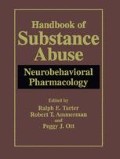Abstract
America is now in a second cycle of hallucinogen abuse; the first centered on lysergic acid diethylamide or LSD in the 1960s and the present one involves methylenedioxymethamphetamine or MDMA and its congeners. The long-term consequences of all hallucinogens have certain similarities, resulting from the intense effect of these drugs on the brain’s cognitive centers. While all hallucinogens have some relation in action to the stimulant drugs, this relation is particularly pronounced in such drugs as MDMA and MDA that have specific stimulant components and produce a combination of hallucinogenic and stimulant effects.
Access this chapter
Tax calculation will be finalised at checkout
Purchases are for personal use only
Preview
Unable to display preview. Download preview PDF.
References
Alpert, R. (1967). Psychedelic drugs and the law. Journal of Psychedelic Drugs, 1, 7–26.
American Psychiatric Association. (1994). Diagnostic and statistical manual of mental disorders ( 4th ed. ). Washington, DC: Author.
Cohen, S. (1960). Lysergic acid diethylamide: Side effects and complications. Journal of Nervous and Mental Disease, 130, 30–40.
Greer, G., and Tolbert, R. (1986). Subjective reports of the effects of MDMA in a clinical setting. In R. B. Seymour, D. R. Wesson, and D. E. Smith, (Eds.), MDMA: Proceedings of the conference. Journal of Psychoactive Drugs, 18, 319–328.
Hallissy, E. (1993, March 24). Use of “Speed” drug rising in state. San Francisco Chronicle, pp. 1, 12.
Hayner, G. N., and McKinney, H. E. (1986). MDMA: The dark side of ecstasy. In R. B. Seymour, D. R. Wesson, and D. E. Smith (Eds.), MDMA: Proceedings of the Conference. Journal of Psychoactive Drugs, 18, 341–348.
Leary, T., Metzner, R., and Alpert, R. (1964). The psychedelic experience: A manual based on the Tibetan Book of the Dead. New Hyde Park, NY: University Books.
Metzner, R. (1978). Reflections on LSD—Ten years later. Journal of Psychedelic Drugs, 10, 137–140.
Michaux, H. (1963). Miserable miracle (L. Varese, Trans.). San Francisco: City Lights Books.
Newmeyer, J., and Johnson, G. (1979). Drug emergencies in crowds: An analysis of “rock medicine.” Journal of Psychedelic Drugs, 9, 235–245.
Seymour, R. B., and Smith, D. E. (1987). Drugfree: A unique, positive approach to staying off alcohol and other drugs. New York: Facts on File.
Seymour, R. B., and Smith, D. E. (1991). Hallucinogens. In N. S. Miller (Ed.), Comprehensive handbook of drug and alcohol addiction (pp. 455–476 ). New York: Dekker.
Seymour, R. B., and Smith, D. E. (1993). The psychedelic resurgence: Treatment, support, and recovery options. Center City, MN: Hazelden.
Smith, D. E. (1967). [Editor’s Note]. Journal of Psychedelic Drugs, 1,1–5.
Smith, D. E., and Luce, J. (1969). Love needs care. Boston: Little, Brown.
Smith, D. E., and Seymour, R. B. (1985). Dream becomes nightmare: Adverse reactions to LSD. Journal of Psychoactive Drugs, 17, 297–303.
Smith, D. E., and Shick, J. F. E. (1970). Analysis of the LSD flashback. Journal of Psychedelic Drugs, 3, 13–19. Smith, D. E., and Wesson, D. R. (1975). [Editors’ Note]. Journal of Psychoactive Drugs, 7, 11 I-1 14.
Wesson, D. R., and Smith, D. E. (1978). Psychedelics. In A. Schecter (Ed.), Treatment aspects of drug dependence (pp. 148–160 ). West Palm Beach, FL: CRC.
Wesson, D. R., and Smith, D. E. (1979). Amphetamine use, misuse and abuse. New York: G. K. Hall.
Wolfe, T. (1968). The electric kool-aid acid test. New York: Bantam.
Author information
Authors and Affiliations
Editor information
Editors and Affiliations
Rights and permissions
Copyright information
© 1998 Springer Science+Business Media New York
About this chapter
Cite this chapter
Seymour, R.B., Smith, D.E. (1998). Psychological and Psychiatric Consequences of Hallucinogens. In: Tarter, R.E., Ammerman, R.T., Ott, P.J. (eds) Handbook of Substance Abuse. Springer, Boston, MA. https://doi.org/10.1007/978-1-4757-2913-9_16
Download citation
DOI: https://doi.org/10.1007/978-1-4757-2913-9_16
Publisher Name: Springer, Boston, MA
Print ISBN: 978-1-4419-3297-6
Online ISBN: 978-1-4757-2913-9
eBook Packages: Springer Book Archive

